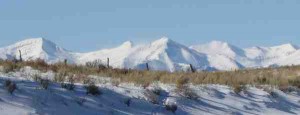Column by George Sibley
Development – February 2008 – Colorado Central Magazine
CRESTED BUTTE has been getting media attention lately that ranges from the haughtily skeptical to the outright critical. A full-fledged resort community today — skiing in the winter and a diversity of mountain recreations in the summer — Crested Butte is now faced with a proposal from a mining company to put a major molybdenum mine near the town. Molybdenum is a mineral that could be considered foundational to the modern resort economy. A super lubricant and an alloy that makes steel lighter and harder, it is used in everything from the airplanes and autos the resort habitués arrive in to the skis and bikes they use while here.
But Crested Butte does not want this mine — although its residents hope that molybdenum mined somewhere else will continue to contribute to bringing visitors here and keeping them entertained while here, as well as contributing what it adds to their personal lives. This ambivalence is bringing charges of NIMBYism down on the community — “Not In My Back Yard!” Even though somebody must do what needs to be done to maintain my “lifestyle,” do it somewhere else!
On the surface of it, Crested Butte is vulnerable to this charge, but from a little closer to the situation, it feels like a typical American 20th-century oversimplification, to avoid confronting a typical American 21st-century problem.
I was in Crested Butte at a time when the town would have welcomed this mine, or any mine, or anything at all — and that wasn’t all that long ago. When I arrived in Crested Butte in 1966, I got a job that required a lot of shovel work — but it was for the ski industry, not a mine. My job was ski patrolman, when slope maintenance was part of the ski patrol’s work.
At that time, Crested Butte was a mining town on its way to being a resort town too (a resort town in addition to being a mining town). Crested Butte had come into being in the 1880s as a mining town, and the majority of the people who lived there in the 1960s still thought of it as a mining town that was temporarily lacking a working mine.
I’ve argued, but not too loudly in the wrong bar, that what killed coal-mining in Crested Butte was the town’s hero, John L. Lewis: He brought decent wages and treatment to the coal miners, and once Colorado Fuel and Iron started paying that kind of money and attention to miners, in addition to covering big transportation expenses, the remote Crested Butte coal became too expensive. CF&I could get coal almost as good from mines much closer to their Pueblo mills, so they shut down Crested Butte’s Big Mine.
AT THAT POINT, those who could not afford to leave Crested Butte had to scrabble for an economy. They already had enough people visiting in the summer to know that, to some extent, “you could eat scenery,” and they welcomed the ski area that entrepreneurs brought in around 1960. But they also believed that mining was the only economy of substance. “Got to have the lunchbucket,” they were still saying when I got there. And they had courted one of the naively dirty companies of mid-20th-century American mining, American Smelting and Refining, to reopen an old mine on Mount Emmons just west of town — the mountain currently proposed for molybdenum production.
So when I got there in 1966, to work on the ski patrol, that was the situation: the Crested Butte Ski Area was operating on the mountain just east of town, and the Keystone Mine was operating on the mountain just west of town. Both were marginal and struggling, but always “showing promise.”
Through happenstance, I became editor of the town newspaper, and that was the economy I reported on. One week I might report that a huge Kansas ski club had come to town (anything more than a fifteen-passenger van full); the next week I might be reporting that the R&D drillers at the Keystone had yet again found The Vein in the fractured geology of Mt. Emmons.
TO A TYPICAL 20th-century graduate of 19th-century liberal arts education, knowing nothing of practical value, I thought that was a pretty decent economic future: a mine and a ski area; diversity sounded intuitively good. Don’t have all your eggs in one basket. I was also part of an idealistic movement in the community to develop an educational component — I occasionally editorialized ambitiously about “The Summer University of the Rockies.” That was my vision — a town in which miners and resort workers went west and east in the morning to their respective mountains, but returned to rub elbows in the same bars and restaurants after work — and maybe went to the same evening class to improve their livelihoods or lives.
My obvious naivety would be embarrassing were it not for the fact that, to a certain extent, it was actually Crested Butte’s situation in the late 1960s. There were testosteronal tensions between the sons of the “old-timer” mining families and the sons of the suburbs migrating to the unsuburban mountains, but in terms of both work and attitude, the differences were unsustainable. Whether you were shoveling muck in the mine or snow on the slopes, it was all the Brotherhood of the Muckstick, and everyone was about equally poor. My newspaper reported everything that was going on with equal measures of boosterish enthusiasm, and that generally reflected the attitude of the community at large.
Then, of course, everything started to change, in the manner of the American West, with outside money moving in. In 1970 the ski resort got new ownership and a big infusion of outside capital, and skiing and related businesses took off dramatically in the 1970s. The Keystone Mine, meanwhile, went very quiet around that same time; nothing seemed to be going on (although later events proved that partially untrue). The reportable news was all about new restaurants, ski lifts, resort-type businesses, a new town sewer system to handle the load, three tries on a sales tax to handle the infrastructure, et cetera. The mining side of Crested Butte mostly fell out of consciousness — except, of course, for the “mining heritage,” which is a marketable item in a resort economy.
Suppose that the outside money in 1970 had come to invest in, say, a big molybdenum deposit in Mt. Emmons rather than the ski area? My guess is that today Crested Butte would be in its third decade of producing moly. Would it still have a ski resort too?
Instead, by the late 1970s when AMAX Mining stated its desire to pump a lot of money into a moly mine on Mt. Emmons, it was already too late for cheers to greet the announcement. Except for the residual handful of “old-timers,” the idea of a major mining operation was perceived as a threat to the growing resort economy.
An honest effort was made, circa 1980, to try to figure out how a mine — maybe a smaller mine — could be shoehorned into the Crested Butte area, but before anything was resolved, the price of moly collapsed and AMAX abandoned its plans. Now, almost three decades later, the price of moly is at record highs, and the idea of a mine is back on the table, with the industry back under a new name. But the local economy is a generation farther along the resort track now — having in the interim exhausted the initial infusion of outside money and received another just a few years ago. An incredible amount of building has gone on, with ever larger homes spreading up the ridges and down the valley from Crested Butte. Where do we have an extra valley to fill up with tailings that wouldn’t threaten the megamanors already filling up our valleys?
MOST OF THE “NIMBYs” who strenuously oppose the mine are not much happier with the grow-or-die mantra driving industrial resortism, or the growing inequality between non-working residents and non-resident workers, or the generally lousy wages, but that’s the devil we married back in 1970, like it or not, and the mine is the devil we don’t need now in addition.
Succumbing every so often to nostalgia, I find myself wondering where we would be today, had both the Keystone Mine and the Crested Butte Ski Area continued to bumble and muddle along incrementally these past 30 years with only modest investments, alternately growing and shrinking a little as they did through the 1960s. What would the town between the two mountains be like today?
But that’s not the way things happen in the West. I think of something contrarian economist Leopold Kohr said: “Wherever something is wrong, something is too big.” And these mountain valleys are just too small for two things that are too big. “NIMBY” might more often be a cry of real stress and distress than a claim of false virtue.
George Sibley, who recently retired from professing at Western State College, writes from gelid Gunnison.


